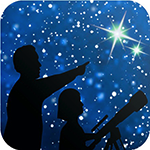On August 1st, catch a full Moon rising in the east just 30 minutes after sunset. We are seeing the entire sunlit side of the Moon as it is nearly (but not quite) in line with the Sun and Earth. The Farmers’ Almanac calls this month’s Moon the “Sturgeon Moon”, for the time of year when this giant fish was once abundant in the Great Lakes. Cultures around the world give full Moons special names, often related to growing seasons or celebrations.
Category Archives: NASA Space Place
Find A Ball of Stars
French astronomer Charles Messier cataloged over 100 fuzzy spots in the night sky in the 18th century while searching for comets – smudges that didn’t move past the background stars so couldn’t be comets. Too faint to be clearly seen using telescopes of the era, these objects were later identified as nebulas, distant galaxies, and star clusters as optics improved. Messier traveled the world to make his observations, assembling the descriptions and locations of all the objects he found in his Catalog of Nebulae and Star Clusters. Messier’s work was critical to astronomers who came after him who relied on his catalog to study these little mysteries in the night sky, and not mistake them for comets.
Look Up in the Sky – It’s a Bird
Bird constellations abound in the night sky, including Cygnus, the majestic swan. Easy to find with its dazzling stars, it is one of the few constellations that look like its namesake and it is full of treasures. Visible in the Northern Hemisphere all summer long, there’s so much to see and even some things that can’t be seen. To locate Cygnus, start with the brightest star, Deneb, also the northeastern most and dimmest star of the Summer Triangle. The Summer Triangle is made up of three bright stars from three different constellations – read more about it in the September 2022 issue of Night Sky Notes. “Deneb” is an Arabic word meaning the tail. Then travel into the triangle until you see the star Albireo, sometimes called the “beak star” in the center of the summer triangle. Stretching out perpendicular from this line are two stars that mark the crossbar, or the wings, and there are also faint stars that extend the swan’s wings.
Solar Eclipses Are Coming!
Have you ever witnessed a total solar eclipse? What about an annular solar eclipse? If not, then you are in luck if you live in North America: the next twelve months will see two solar eclipses darken the skies for observers in the continental United States, Mexico, and Canada!
Spot the Morning and Evening Star: Observe Venus
Venus is usually the brightest planet in our skies, and is called “Earth’s Twin” due to its similar size to Earth and its rocky composition. However, Venus is a nightmare version of our planet, featuring a thick, crushing atmosphere of acidic clouds, greenhouse gasses, howling winds, and intense heat at its surface.
Spot the King of Planets: Observe Jupiter
Jupiter is our solar system’s undisputed king of the planets! Jupiter is bright and easy to spot from our vantage point on Earth, helped by its massive size and banded, reflective cloud tops. Jupiter even possesses moons the size of planets: Ganymede, its largest, is bigger than the planet Mercury. What’s more, you can easily observe Jupiter and its moons with a modest instrument, just like Galileo did over 400 years ago.
Spot the Messenger: Observe Mercury
Most planets are easy to spot in the night sky, but have you spotted Mercury? Nicknamed the Messenger for its speed across the sky, Mercury is also the closest planet to the Sun. Its swift movements close to our Sun accorded it special importance to ancient observers, while also making detailed study difficult. However, recent missions to Mercury have resulted in amazing discoveries, with more to come.
Binoculars: A Great First Telescope
Do you want to peer deeper into the night sky? Are you feeling the urge to buy a telescope? There are so many options for budding astronomers that choosing one can be overwhelming. A first telescope should be easy to use and provide good quality views while being affordable. As it turns out, those requirements make the first telescope of choice for many stargazers something unexpected: a good pair of binoculars!
Cepheus: A House Fit for a King
Sometimes constellations look like their namesake, and sometimes these starry patterns look like something else entirely. That’s the case for many stargazers upon identifying the constellation of Cepheus for the first time. These stars represent Cepheus, the King of Ethiopia, sitting on his throne. However, many present-day observers see the outline of a simple house, complete with peaked roof, instead – quite a difference! Astronomers have another association with this northern constellation; inside its borders lies the namesake of one of the most important types of stars in modern astronomy: Delta Cephei, the original Cepheid Variable.
Fomalhaut: Not So Lonely After All
Fall evenings bring a prominent visitor to southern skies for Northern Hemisphere observers: the bright star Fomalhaut! Sometimes called “The Autumn Star,” Fomalhaut appears unusually distant from other bright stars in its section of sky, leading to its other nickname: “The Loneliest Star.” Since this star appears so low and lonely over the horizon for many observers, is so bright, and often wildly twinkles from atmospheric turbulence, Fomalhaut’s brief but bright seasonal appearance often inspires a few startled UFO reports. While definitely out of this world – Fomalhaut is about 25 light years distant from us – it has been extensively studied and is a fascinating, and very identified, stellar object.

